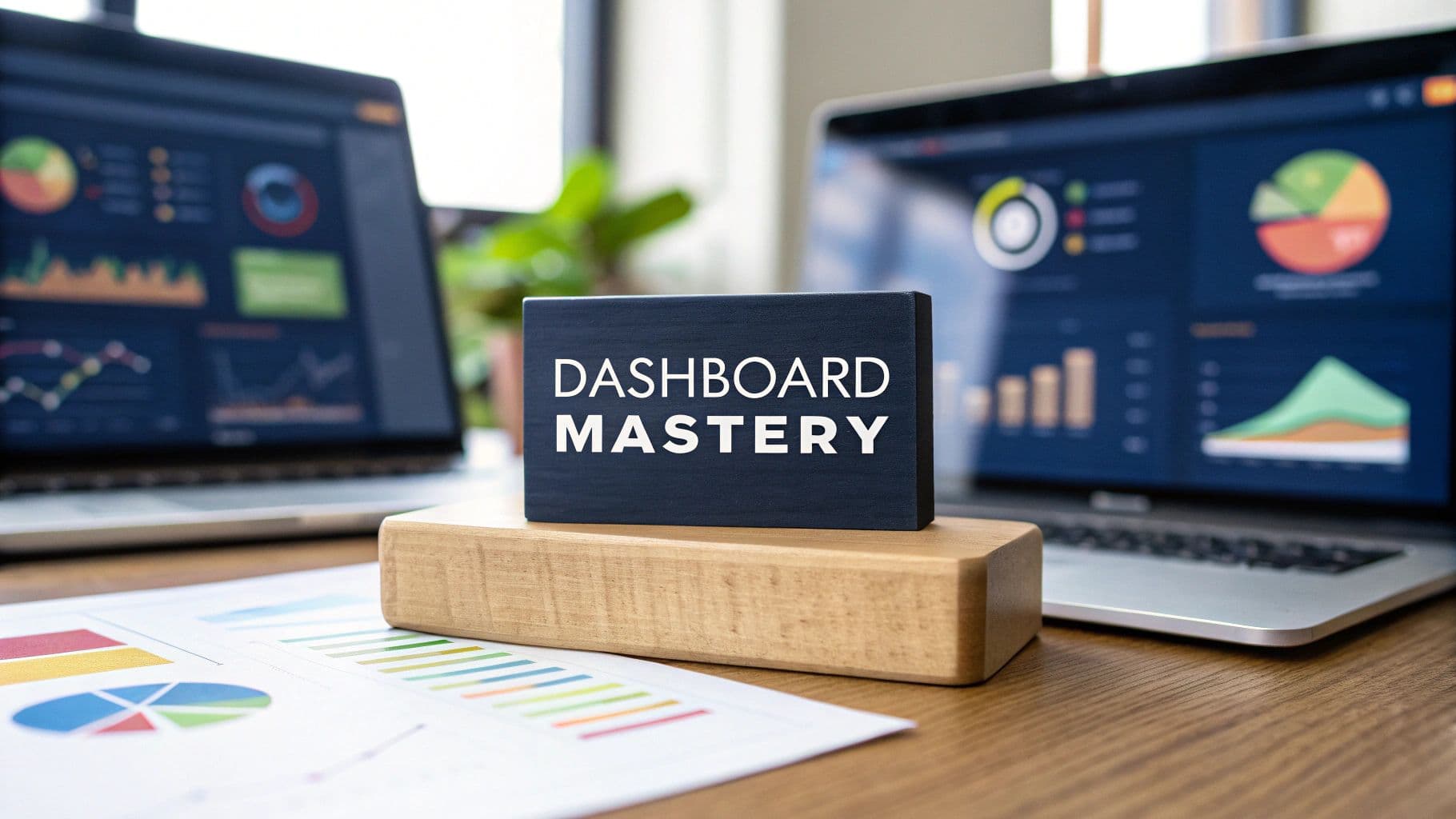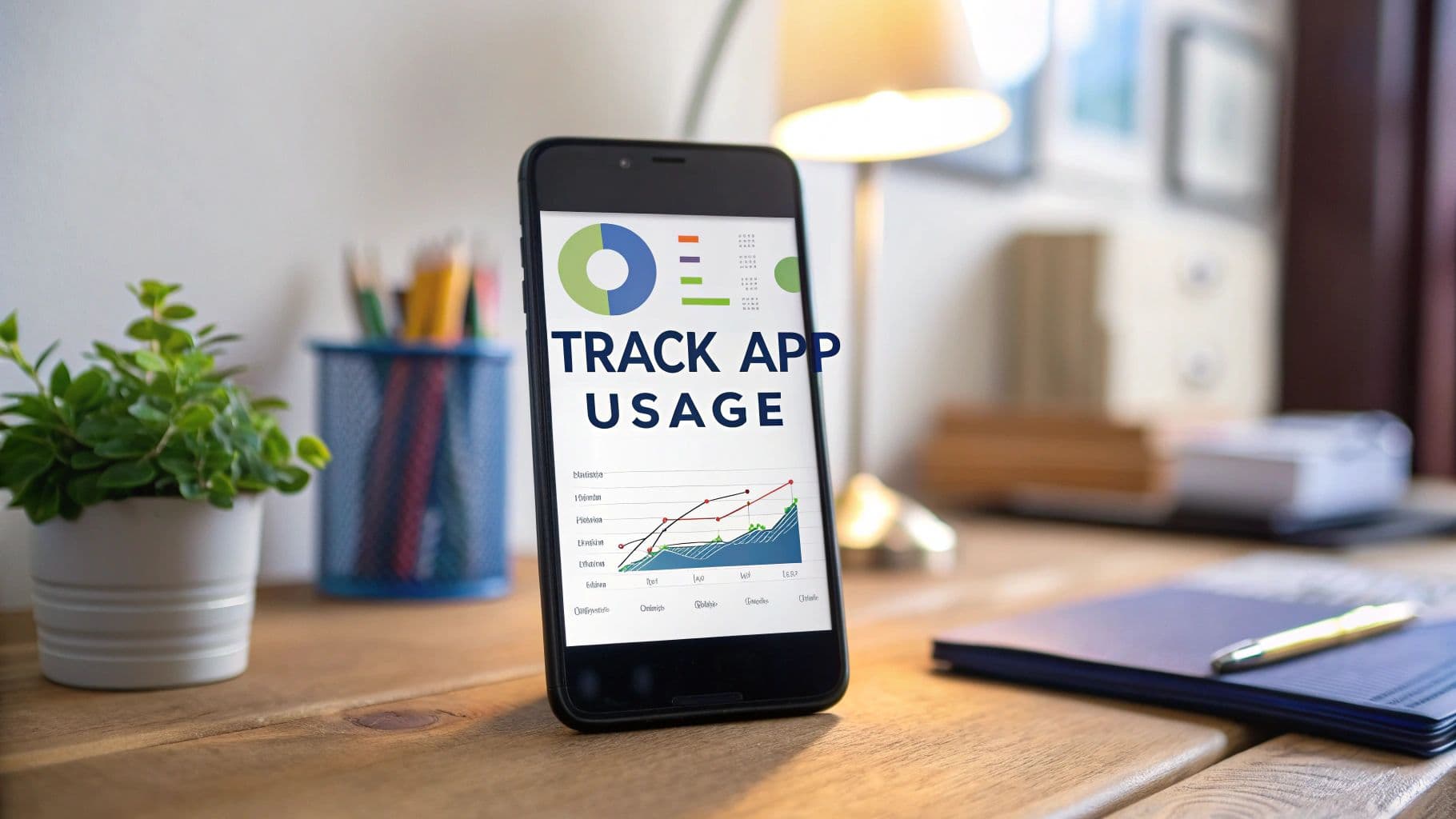Build a Predictive Churn Model That Retains Customers
Learn to build a predictive churn model to stop customer loss. This guide covers data, algorithms, and action plans for better customer retention.
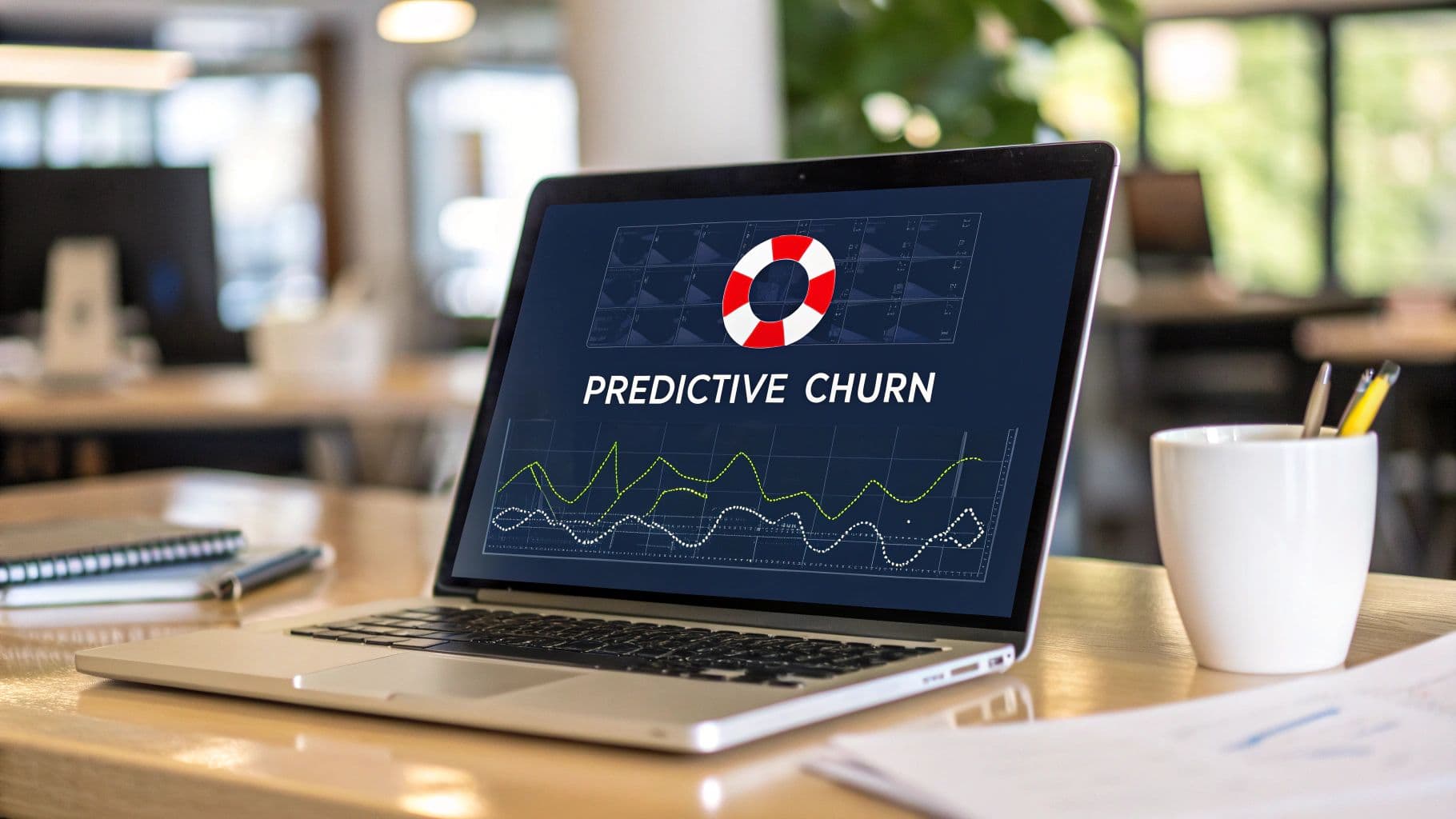
A predictive churn model is essentially an early warning system for your business. It dives into your historical customer data, using machine learning to identify the subtle patterns that signal a customer is about to leave. This allows you to step in before they walk out the door for good.
Why Predictive Churn Models Are Your Secret Weapon

Customer churn is a silent killer of growth. Picture your business as a bucket you’re constantly trying to fill with new customers. While your marketing team pours new leads in the top, churn creates tiny, almost invisible leaks at the bottom. Left unchecked, those leaks drain revenue and make sustainable growth feel impossible.
For years, most businesses handled churn reactively. They'd wait for a customer to cancel, then send an exit survey to figure out what went wrong. It’s a bit like investigating a fire after the building has already burned down. The damage is done.
The Shift from Reactive to Proactive Retention
Predictive churn models flip this entire approach on its head. Instead of asking, "Why did they leave?" you can finally ask, "Who is likely to leave, and what can we do to convince them to stay?"
This shift from a reactive to a proactive mindset is a game-changer for any company. By analyzing patterns in behavior, product usage, and support interactions, the model assigns a "churn score" to every customer. Suddenly, you have a clear, data-backed list of who needs your attention right now.
This foresight is incredibly powerful. It means you can build targeted retention strategies that actually work. For example, you can:
- Segment at-risk users and have your customer success team reach out with personalized help.
- Trigger automated email campaigns offering a special discount or highlighting a feature they haven't used yet.
- Prioritize product updates that solve the exact friction points pushing people away.
The shift towards predictive analytics isn't just a trend; it's becoming standard practice. Let's look at how the thinking has evolved.
Reactive vs Proactive Customer Retention Strategies
| Aspect | Reactive Approach (Without a Model) | Proactive Approach (With a Predictive Model) |
|---|---|---|
| Timing | Acts after a customer has already canceled their subscription. | Intervenes before a customer shows clear intent to leave. |
| Focus | Understanding past failures (e.g., "Why did they leave?"). | Preventing future losses (e.g., "Who might leave next?"). |
| Data Usage | Analysis of historical churn data and exit survey feedback. | Real-time analysis of behavioral data, usage, and support tickets. |
| Strategy | Win-back campaigns aimed at already-lost customers. | Targeted outreach, special offers, and support for at-risk users. |
| Efficiency | Often inefficient and costly, with very low success rates. | Highly efficient, maximizing the impact of retention efforts. |
| Outcome | High customer acquisition costs to replace lost revenue. | Improved customer lifetime value and lower overall churn. |
As you can see, the proactive approach is about getting ahead of the problem instead of just cleaning up the mess.
The market reflects this change. The global customer churn software market is set to grow at a compound annual growth rate of 9.3% from 2025 to 2035. This huge investment shows just how many businesses are waking up to the power of predictive analytics. You can find more detail on this trend in a market analysis from Wise Guy Reports.
By using a predictive churn model, you turn your retention efforts from guesswork into a data-driven science. It becomes your secret weapon, helping you patch the leaks in your customer bucket, boost loyalty, and build a more stable path to growth.
Gathering the Right Data for Your Churn Model
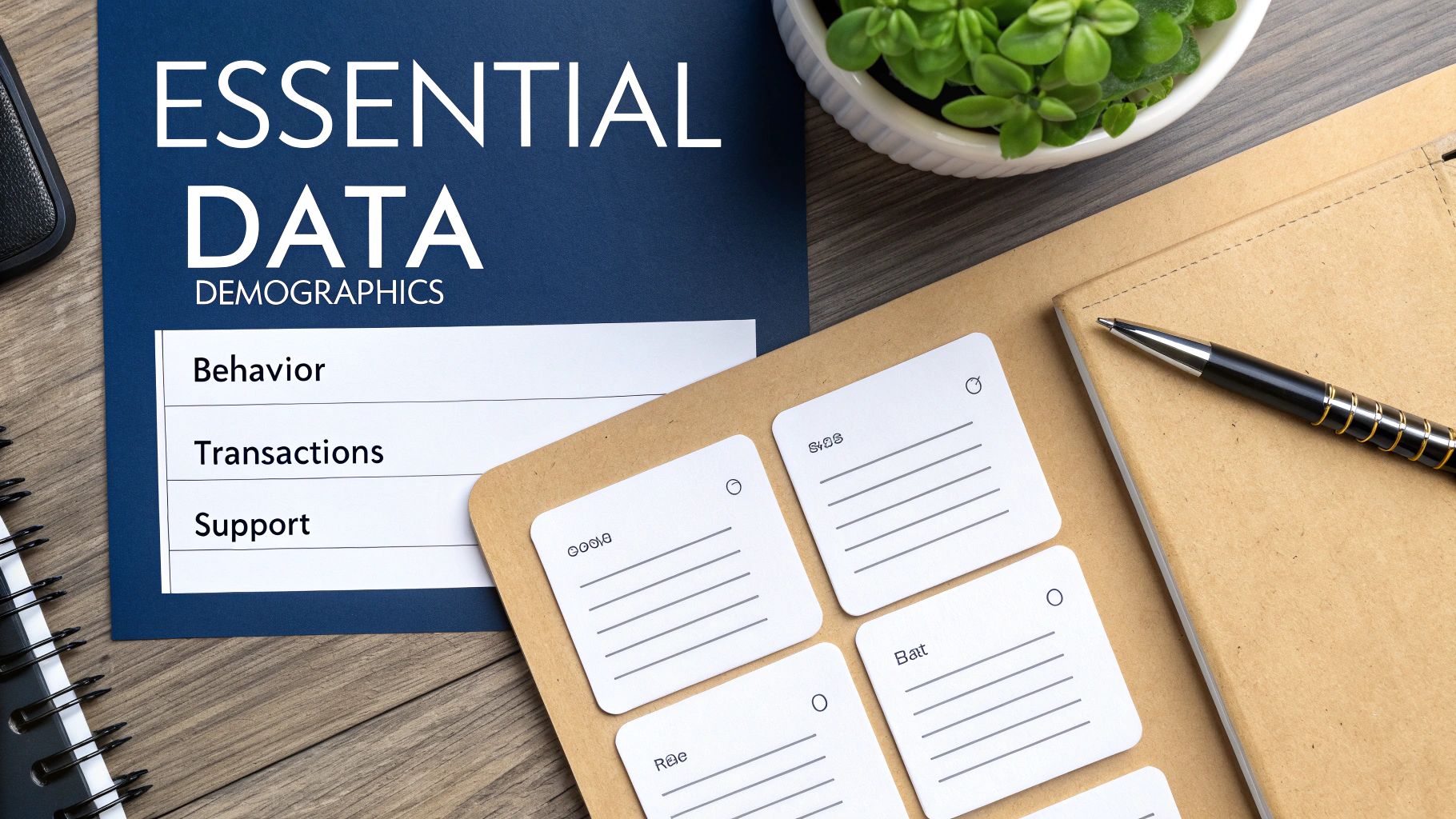
Any predictive churn model is only as good as the data it’s trained on. Think of it as a classic case of "garbage in, garbage out." You can have the most sophisticated algorithm on the planet, but if you feed it flimsy or incomplete information, its predictions will be useless.
The real work starts with getting a single, unified view of your customer. This means breaking down the data silos that exist in almost every company. Your customer information is likely scattered across your CRM, billing platform, support desk, and product analytics tools. To build a reliable predictive churn model, you have to pull all of that together.
This unification isn’t just a nice-to-have; it's the bedrock of the entire project. It's less about just collecting data and more about connecting the dots between different systems. Building solid processes to move and consolidate this information is a job in itself. If you're wondering where to start, you can learn more about this in our guide on how to build data pipelines.
The Four Pillars of Churn Prediction Data
To truly understand what drives churn, you need to look at your customers from multiple angles. We generally group the necessary data into four key categories, with each one telling a different part of the story.
- Demographic and Firmographic Data: This is the basic "who" and "what" of your customer. Think company size, industry, location, and what subscription plan they're on. This data is great for segmenting your user base and spotting if, for example, mid-market tech companies in Europe churn more than others.
- Transactional Data: This covers the entire financial history you have with a customer. We're talking about their subscription start date, total contract value, payment history (especially failed payments), and any upgrades or downgrades. It’s a direct look at the health of the commercial relationship.
- Behavioral Data: This is where things get really interesting. This data shows you how customers are actually using your product. Are they logging in daily? Are they using the "sticky" features you know lead to long-term value? A sharp decline in product usage is often the loudest alarm bell for churn.
- Support and Engagement Data: This bucket captures every conversation and interaction a customer has with your team. How many support tickets have they filed? How severe were the issues? What were their CSAT scores? You can even analyze the sentiment from chat logs to get a feel for their general happiness.
The Art of Feature Engineering
Once you’ve gathered all this raw information, you can't just dump it into a model. The next step is feature engineering, which is a fancy way of saying you need to turn raw data points into smart signals that the model can actually learn from. This is where your business expertise comes into play.
For instance, instead of just using a raw "last login date," a much smarter feature would be "days since last meaningful action." There's a world of difference between a user who logs in to glance at a dashboard and one who actively uses a core creative tool.
Here are a few other examples of engineered features:
- Support Ticket Ratio: How many negative or urgent tickets have they submitted versus positive ones?
- Adoption Velocity: How quickly does a new customer start using your most important features?
- Team Penetration: For team accounts, what percentage of their purchased seats are actually being used?
To create features like these, you absolutely need a rich history of data. This is why having effective data retention policies in place long before you start is so important. Feature engineering is where you clean up your raw ingredients and add the context that transforms a good model into a great one.
Choosing The Right Algorithm For Churn Prediction
Picking the right algorithm for a churn prediction model is a bit like choosing a vehicle. Are you looking for a reliable, easy-to-understand sedan for a daily commute, or a high-performance race car that can deliver maximum speed, even if it’s a lot harder to handle?
The decision really boils down to a classic trade-off: interpretability versus predictive power. Interpretability is all about how easily you can explain why the model predicted a certain outcome. Predictive power, on the other hand, is purely about accuracy. There's no single "best" algorithm—the right one depends on your team's skills, your business goals, and how deep you need to go with your insights.
Simple and Interpretable Models
If your team is just getting started with predictive churn modeling, simpler algorithms are usually the way to go. Their biggest selling point is transparency. You can see exactly which factors are pushing customers toward the exit.
Logistic Regression is the undisputed workhorse in this category. Think of it as that dependable family sedan. It works by calculating the probability that a customer will churn based on a straightforward combination of inputs, like how often they log in or how many support tickets they've submitted.
Its greatest strength is that it’s a "white-box" model. You can literally look at the model’s outputs and say, "For every extra support ticket a customer files, their churn risk goes up by X%." This makes it incredibly easy to explain the why behind a churn score to people in marketing or customer success.
High-Performance Complex Models
When your main objective is to squeeze out every last drop of accuracy, more complex "black-box" models are your best bet. These are the high-performance sports cars of the modeling world. They’re brilliant at finding subtle, non-linear patterns in your data that simpler models just can't see, which ultimately leads to much sharper predictions.
- Random Forests: This technique builds hundreds—sometimes thousands—of individual decision trees and then polls them for a final answer. This "wisdom of the crowd" approach makes the model incredibly accurate and robust against overfitting (a common problem where a model gets too good at predicting old data and fails with new data).
- Gradient Boosting Machines (GBMs): These are some of the most powerful and popular algorithms out there for churn prediction. A GBM works by building a series of models, where each new one learns from and corrects the mistakes of the one before it. It’s an iterative process that leads to an exceptionally precise final model.
Machine learning is central to predicting customer churn, but different algorithms offer different strengths. Logistic regression shines when you need to understand the 'why,' while advanced models like random forests and GBMs often win on pure predictive accuracy. To dive deeper into this, you can find more insights on choosing the best ML models on Pecan.ai.
The choice of algorithm is a critical step in building an effective churn prediction system. Below is a table that breaks down the most common models, helping you weigh their pros and cons based on your specific needs.
Comparison of Common Churn Prediction Algorithms
| Algorithm | Best For | Pros | Cons |
|---|---|---|---|
| Logistic Regression | Teams needing clear, explainable results to understand churn drivers. A great starting point. | Simple to implement, highly interpretable ("white-box"), computationally efficient. | May not capture complex, non-linear relationships, potentially lower accuracy than other models. |
| Random Forest | Achieving high accuracy while maintaining some level of feature importance insight. | Strong predictive power, robust to outliers and overfitting, can handle many types of data. | Can be a "black-box" (harder to interpret), may require more computational resources than simpler models. |
| Gradient Boosting (GBM) | Maximizing predictive accuracy for mission-critical tasks like automated retention campaigns. | Often delivers the highest accuracy, excels with structured data, very flexible. | Highly sensitive to tuning, can easily overfit if not careful, very difficult to interpret individual predictions. |
As you can see, there isn't a one-size-fits-all solution. The best algorithm for your business depends entirely on what you're trying to achieve.
How to Make The Right Choice
So, which path should you take? Start by thinking about what you need this model to do.
If your primary goal is to understand the fundamental drivers of churn to inform your product roadmap or overall strategy, a transparent model like Logistic Regression is a fantastic place to start.
But if you’re building a highly targeted, automated retention campaign where every percentage point of accuracy translates into serious revenue saved, then a powerhouse algorithm like a GBM is probably the right call. A common path for many businesses is to start with a simple model to get some quick wins and insights, then graduate to more complex ones as their data science capabilities and business needs mature.
Your Step-By-Step Model Building Playbook
Alright, let's get our hands dirty. Moving from theory to practice is where the real value starts to show up. Building your first predictive churn model doesn't mean you need a PhD in data science, but it does require a clear, methodical plan. This playbook breaks the whole process down into five straightforward stages, taking you from a spreadsheet of raw data to insights you can actually use.
Think of it like building a custom piece of furniture. You start with a blueprint, gather your wood and tools, assemble the main parts, check if it's wobbly, and then sand down the rough edges for a perfect finish. Every single step is critical if you want a final product that's both reliable and useful.
Stage 1: Define Your Churn Event
First thing’s first: before you can predict churn, you have to decide exactly what "churn" means for your business. This definition is the North Star for your entire project. Is a customer considered churned the moment they click "cancel," or is it only after 30 days of total inactivity on a free plan?
A SaaS company might call churn a simple subscription non-renewal. On the other hand, an e-commerce business might define it as any customer who hasn't made a purchase in the last 90 days.
Stage 2: Split Your Data
With your churn definition locked in, the next crucial step is to divide your historical customer data into two separate piles: a training set and a testing set. This is probably the most important rule in all of machine learning. The training set is the bigger chunk, usually 70-80% of your data, that you'll use to teach the model.
The remaining 20-30% becomes the testing set, and you need to keep it completely separate. This set acts as the final exam for your model, grading its performance on data it has never seen before.
Why is this so vital? If you test a model on the same data you used to train it, it’s like giving a student the exam questions and the answers ahead of time. Of course they'll score 100%, but you'll have no idea if they actually learned the material or just memorized the answers. This separation prevents a common problem called overfitting and ensures your model can make accurate predictions out in the real world.
Stage 3: Train The Model
Now for the fun part: training. In this phase, you feed that big training dataset to your chosen algorithm, whether it's something like Logistic Regression or a Random Forest. The model gets to work, crunching through all that historical data to find the subtle patterns and hidden connections between customer behaviors and the churn event you defined earlier.
It learns which features are the strongest signals. For example, it might discover that a sharp drop in login frequency combined with a recent price hike dramatically increases the probability of a customer leaving. The algorithm is essentially fine-tuning its internal logic to create the most accurate predictive formula it can based on the patterns it uncovers.
The infographic below illustrates the different paths an algorithm can take—from the straightforward, easy-to-understand approach of Logistic Regression to the more complex, high-performance route of a Random Forest.
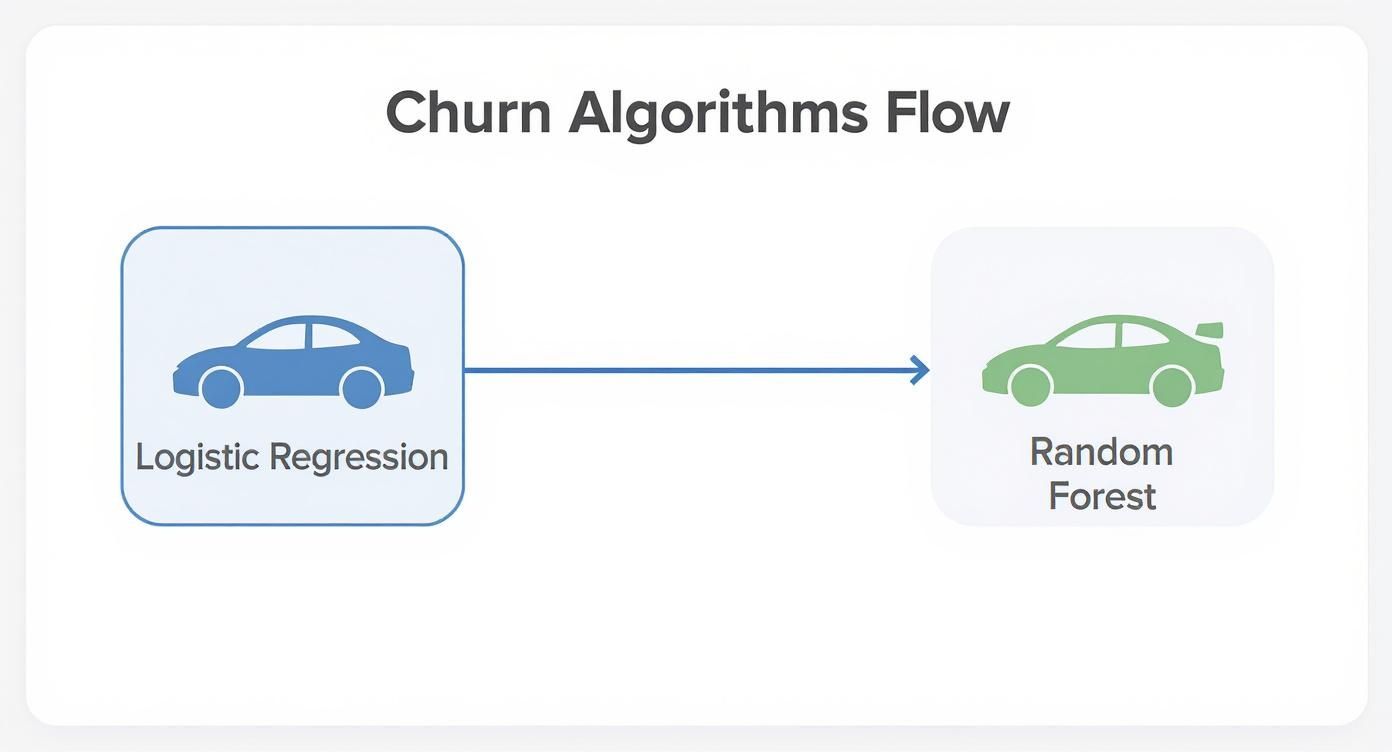
As you can see, simpler models give you a direct, interpretable path to insights, while more advanced algorithms take a more winding road to achieve higher accuracy.
Stage 4: Evaluate Model Performance
Once the model is trained, it's time to bring out that testing set you put aside. You run this unseen data through your model and then compare its predictions to what actually happened. Did the customers your model flagged as high-risk really end up churning?
We use a few key metrics to measure performance:
- Precision: Of all the customers the model predicted would churn, how many actually did?
- Recall: Of all the customers who actually churned, how many did the model correctly catch?
- F1-Score: A balanced average of precision and recall, giving you a single, tidy score for overall performance.
This evaluation is your report card. It tells you whether your model is a reliable forecasting tool or if it’s time to go back to the drawing board.
Stage 5: Refine and Iterate
Let’s be honest: no model is perfect on the first try. Based on your evaluation, the final stage is all about refinement. This could mean tuning hyperparameters (the algorithm’s internal settings), creating new features from your data that you might have missed, or even trying a different algorithm entirely.
This loop—train, evaluate, refine—is how you turn a pretty good model into a great one that delivers real, tangible value to the business.
Measuring Success and Proving ROI
So, you’ve built a predictive churn model. That's a huge technical win, but the work isn't over. A functional model doesn't automatically equal a business success. To justify the time and resources you've invested, you need to prove it delivers real, measurable value.
The biggest trap people fall into is obsessing over model accuracy. Seeing an accuracy of 98% looks fantastic on a report, but for churn prediction, it can be incredibly deceptive. Think about it: if your company has a low monthly churn rate of just 2%, a lazy model that predicts no one will ever churn would still be 98% accurate. It's technically correct most of the time, but completely useless for actually preventing customer loss.
Moving Beyond Simple Accuracy
Because churn is usually a rare event, we're dealing with what's called an imbalanced dataset. This means we need smarter metrics to understand how well our model is really doing.
I like to think of a churn model as a smoke detector. Its job is to find the fire (the customers about to leave) before it engulfs the whole house. You'd much rather have a detector that occasionally gives a false alarm than one that stays silent while your business is burning down.
This is where a few key metrics come into play:
- Precision: Out of all the customers your model flagged as "at-risk," how many of them actually left? High precision means your retention efforts are hitting the right targets, not wasting money on happy, loyal customers.
- Recall: Of all the customers who actually did churn, what percentage did your model successfully catch beforehand? High recall means you have a good dragnet and aren't letting many at-risk customers slip through the cracks unnoticed.
- F1-Score: This is simply the harmonic mean of Precision and Recall. It gives you a single, balanced score that’s often the best all-around indicator for a churn model's performance.
Translating Metrics into Financial Impact
At the end of the day, the C-suite and your stakeholders measure success in dollars and cents. They want to see a clear return on investment (ROI). You can deliver this by connecting the model’s predictions directly to the financial outcomes of your retention campaigns.
The calculation is pretty straightforward but incredibly powerful:
- Identify At-Risk Revenue: First, use the model to add up the monthly recurring revenue (MRR) of every single customer it flags as a high churn risk.
- Measure Saved Revenue: Now, track how many of those flagged customers you successfully kept on board because of your targeted interventions.
- Calculate ROI: Finally, compare the revenue you saved against what you spent on the retention efforts (like discounts, or the time your success team invested).
This simple framework transforms abstract data science metrics into a rock-solid business case. The conversation shifts from, "Our model's F1-score is 0.82," to, "Our model flagged 150,000 in at-risk revenue last quarter, and our proactive outreach saved ****65,000 of it." That’s the kind of language that gets everyone aligned and excited to keep funding your program.
For a deeper look into this topic, check out our guide on essential customer retention metrics that demonstrate business impact.
Turning Churn Predictions Into Retention Wins

Building a perfectly tuned predictive churn model is a huge achievement, but it's only half the job. The real magic isn't in the predictions themselves—it's in the smart, targeted actions they empower you to take. An accurate forecast is completely useless if it just sits on a dashboard. To see a real return on your investment, you have to bridge the gap between data science and your day-to-day business strategy.
This is where your model stops being a technical tool and starts becoming a revenue-saving engine. The trick is to create clear, automated playbooks that trigger specific interventions based on a customer's churn score. A high score shouldn’t just set off an alarm bell; it should kick off a well-defined retention workflow.
From Insight to Actionable Interventions
Let's say your model flags a customer with an 85% probability of churning. Instead of sending a generic "please stay" email, you can launch a highly specific response based on what the model tells you is driving their risk. This tailored approach is what makes a retention strategy truly effective.
To really nail this, you need to quickly get to the "why" behind the churn score; read how to quickly understand churn drivers without complex queries. Once you know the root cause, you can tailor your response with surgical precision.
Think about these real-world scenarios:
- For a SaaS Company: A user’s high churn score is linked to them barely using a key feature. Instead of a discount, the system automatically creates a task for their Customer Success Manager to offer a free, personalized training session.
- For a Telecom Provider: A customer gets flagged because their data usage has dropped and they've been browsing competitor websites. The playbook immediately triggers a proactive SMS offer for a free plan upgrade with more data—long before they ever think to call and cancel.
A prediction without a corresponding action plan is just trivia. The goal is to build an operational system where every high churn score is met with a swift, relevant, and personalized intervention designed to address the root cause of the risk.
The Future of Prediction Accuracy
This field is moving fast, and new techniques are making these predictions more precise than ever. For instance, hybrid neural network models are showing incredible promise by reducing bias and outperforming older machine learning methods. In the world of finance, models using gradient boosting trees on mobile money data have been incredibly successful at pinpointing at-risk customers.
These more advanced approaches give us much more detailed insights. This allows for hyper-targeted interventions that feel less like a desperate retention tactic and more like genuinely helpful, proactive customer service. When you turn your model’s insights into concrete actions, you create a powerful cycle of prediction, intervention, and loyalty.
For more hands-on strategies, check out our guide on how to https://www.sigos.io/blog/how-to-reduce-customer-churn with practical steps.
Answering Your Top Churn Model Questions
Diving into predictive analytics for the first time is bound to bring up some questions. As you get started with building a churn model, you'll naturally have thoughts about the data you need, how it all works, and what to do with the results. Let's tackle some of the most common questions I hear from teams on this journey.
How Much Historical Data Do I Really Need?
There isn't a single magic number here, but a solid rule of thumb is to start with at least 6 to 12 months of clean, consistent customer data. This window is usually long enough to capture important seasonal trends and the subtle behavioral shifts that often happen right before a customer decides to leave.
But here’s the crucial part: quality trumps quantity every single time. Your model’s biggest need is a meaningful number of actual churn examples to learn from. If only a tiny handful of customers have ever churned, the model will have a hard time spotting reliable patterns, no matter how many terabytes of data you throw at it.
You need enough churned customers in your historical data for the algorithm to learn what "at-risk" behavior actually looks like. If the model has never seen what leaving looks like, it can't possibly flag it for you in the future.
Can a Model Tell Me Why a Customer Is Likely to Churn?
Yes, it absolutely can—but this depends entirely on the type of algorithm you use.
Some models, like Logistic Regression, are what we call "interpretable." They're quite transparent, allowing you to see exactly which factors—like "number of recent support tickets" or "days since last login"—are pushing a customer's churn score up or down. You get a clear "why" behind the prediction.
On the other hand, more complex models like Neural Networks are often called "black boxes." They can be incredibly accurate, but it’s much more difficult to untangle the specific reasons for their predictions. That's why many teams start with a simpler, interpretable model first. They use it to understand the fundamental drivers of churn, then build on those insights to develop more powerful models later.
How Often Should I Retrain My Model?
A churn model isn't something you can just set up once and walk away from. You have to retrain it regularly to combat a phenomenon known as model drift. This happens when your model's predictions become less accurate because customer behavior, your product, or market conditions have changed over time.
For most businesses, retraining the model every quarter or twice a year is a great starting point. If you're in a fast-paced industry with constant product updates or rapidly changing customer demographics, you might even need to do it monthly. The key is to keep an eye on your model's performance. If you see a sudden dip in your go-to metrics like precision or recall, that's a flashing sign that it's time for a refresh with new data.
What's the Single Biggest Mistake People Make?
Hands down, the most common pitfall is treating a churn model as a pure data science project that lives in a vacuum. A model that does nothing but spit out a list of high-risk customers is, frankly, useless.
Real success comes from a tight, collaborative loop between your data team and the people on the front lines—customer success, marketing, and sales. You need a rock-solid plan for what to do the moment a customer gets flagged. Without that operational playbook, your impressive predictive model will just be an interesting academic exercise, never delivering on its true business value.
At SigOS, we specialize in turning messy customer feedback into clear, revenue-driving actions. Our platform connects the dots between support tickets, user behavior, and call transcripts to find the leading indicators of churn. This lets you focus on building features customers actually want—and are happy to pay for. Discover how SigOS can help you reduce churn
Keep Reading
More insights from our blog

